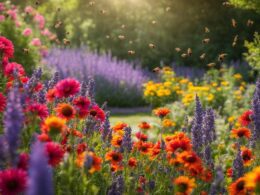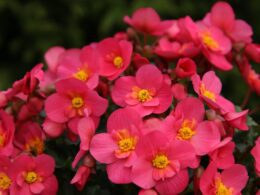If you’re a gardener, you know how devastating it can be when pests invade your plants. One of the most common pests that gardeners face are slugs. These slimy creatures can wreak havoc on your garden, leaving a trail of destruction in their wake.
But what about antirrhinums? Are they on the menu for slugs as well? You may be surprised to learn that slugs do indeed have a taste for antirrhinums. These beautiful flowers, also known as snapdragons, are a favorite snack for slugs. If you’re not careful, your antirrhinums can quickly become a buffet for these pesky critters.
But don’t worry, there are steps you can take to protect your plants and keep them safe from slug damage. In this article, we’ll explore the relationship between slugs and antirrhinums, and provide you with tips on how to keep your garden slug-free.
Introduction to Slugs and Antirrhinums
You’ve probably seen those beautiful snapdragon flowers in your garden, but did you know they have a secret enemy lurking in the shadows? Yes, it’s the common garden slug.
These slimy creatures can be a real pest, especially when it comes to antirrhinums. If you’re growing antirrhinums in your garden, it’s important to be aware of the damage slugs can cause. They love to munch on the leaves and flowers of these plants, leaving them looking sad and wilted.
So, what can you do to protect your antirrhinums from these pesky pests? One effective method of slug control is using slug pellets. These pellets contain a chemical that is toxic to slugs, causing them to stop eating and eventually die.
However, if you prefer a more natural approach, you can try planting slug-resistant antirrhizum varieties, such as ‘Liberty Classic’, ‘Rocket Red’, or ‘Night and Day’. By taking these steps, you can help ensure that your antirrhinums stay healthy and beautiful all season long.
Understanding the Feeding Habits of Slugs
Exploring the dietary preferences of these slimy creatures is crucial to understanding how they survive and thrive in their environment. Slugs are known to feed on a variety of plant species, including antirrhinums. They can cause significant damage to the plant by consuming the leaves, stems, and flowers.
However, there are ways to prevent slug damage to antirrhinums. Slug control can be achieved through organic solutions such as handpicking, using copper barriers, and applying diatomaceous earth. These methods are effective in keeping the slimy creatures at bay and protecting your garden from slug damage.
By understanding the feeding habits of slugs and implementing organic slug control solutions, you can ensure that your antirrhinums remain healthy and vibrant. So, don’t let these slimy creatures ruin your garden. Take action and protect your plants today.
Are Cosmos and Antirrhinums Equally Vulnerable to Slug Attacks?
Cosmos and antirrhinums, also known as snapdragons, both face the challenge of slug attacks. Slugs and their appetite for cosmos can be equally destructive to antirrhinums. These slimy creatures can devour delicate petals and foliage, leaving behind a trail of destruction. To protect these beautiful flowers, gardeners often deploy various anti-slug measures like copper barriers and organic repellents.
The Relationship between Slugs and Antirrhinums
If you want to maintain the health and beauty of your antirrhinums, it’s important to understand the intricate relationship that exists between these delicate flowers and the slimy creatures that may pose a threat to their survival.
Slugs are known to feast on a wide variety of plants, and antirrhinums are no exception. In fact, antirrhinums are often one of the first plants that slugs will go after, as they are attracted to the soft, succulent leaves and stems.
To protect your antirrhinums from slugs, it’s important to employ effective slug control methods. This can include using slug pellets or setting up physical barriers around your plants. You can also try companion planting, which involves planting other species of plants that slugs don’t like near your antirrhinums. This can help to deter slugs from your plants and keep them healthy and thriving.
By taking steps to protect your antirrhinums from slugs, you can ensure that they remain healthy and beautiful for years to come. Whether you choose to use slug pellets, physical barriers, or companion planting, there are plenty of ways to keep your plants safe from these slimy creatures.
With a little bit of effort and attention, you can create a thriving garden that is free from slug damage and full of vibrant, healthy plants.
Preventing Slug Damage to Antirrhinums
To keep your antirrhinums healthy and beautiful, it’s important to protect them from damage caused by these slimy creatures. Slugs can cause significant damage to your plants, leaving holes in the leaves and destroying the flowers. Fortunately, there are several ways to prevent slug damage and keep your antirrhinums thriving.
Here are some organic methods to repel slugs and protect your antirrhinums:
- Use copper tape or wire around the base of your plants. Slugs are repelled by copper and will avoid crossing it.
- Create a barrier of eggshells or diatomaceous earth around your plants. These materials are sharp and will deter slugs from crawling over them.
- Set up beer traps. Slugs are attracted to the yeast in beer and will crawl into the trap, where they will drown.
- Plant slug-repelling herbs like mint, rosemary, and thyme around your antirrhinums. These plants have strong scents that slugs dislike.
By using these methods, you can protect your antirrhinums from slug damage without resorting to harmful chemicals. Not only will your plants be healthier, but you’ll also be doing your part to protect the environment.
Remember, prevention is key when it comes to slug damage. By taking proactive steps to repel slugs, you can keep your antirrhinums safe and beautiful all season long.
Conclusion: Protecting Your Antirrhinums from Slugs
Protecting your antirrhinums from slug damage is crucial for maintaining their health and beauty throughout the season. Slugs can be a major problem for gardeners, especially if you are trying to grow delicate flowers like antirrhinums. These pests can quickly destroy your plants, leaving them ragged and unsightly. However, there are several ways to prevent slug damage and keep your antirrhinums looking their best.
One effective method of slug prevention is to use natural remedies. There are many plants that slugs find unappealing, including lavender, sage, and rosemary. By planting these herbs around your antirrhinums, you can create a natural barrier that slugs will be reluctant to cross. Alternatively, you can sprinkle coffee grounds or eggshells around the base of your plants, as these materials are abrasive to slugs and will deter them from climbing up.
Another way to protect your antirrhinums from slugs is to create physical barriers. You can use copper tape or mesh to create a ring around your plants, as slugs are deterred by the electrical charge that copper produces. Alternatively, you can create a moat around your plants by filling a shallow dish with beer or water. Slugs will be attracted to the liquid and will fall in, unable to climb back out.
In conclusion, there are several effective ways to protect your antirrhinums from slug damage. By using natural remedies, creating physical barriers, and being vigilant about slug control, you can keep your plants healthy and beautiful throughout the season. With a little effort and attention, you can ensure that your antirrhinums thrive and bring joy to your garden for years to come.
Frequently Asked Questions
What is the lifespan of a slug?
Did you know that a slug’s lifespan can vary greatly depending on the species, environmental factors, and predators? Some slugs can live for up to six years, while others may only live for a few months. Despite their slow-moving nature, slugs are quite active and have interesting behaviors such as mating dances and hermaphroditism.
However, slugs also have many predators that can greatly affect their lifespan, such as birds, snakes, and even other slugs. It’s important to understand slug behavior and their predators in order to protect them and maintain a healthy ecosystem.
How do slugs reproduce?
If you’re curious about how slugs reproduce, it’s important to understand their anatomy and mating habits.
Slugs are hermaphrodites, meaning they have both male and female reproductive organs. They mate by exchanging sperm with another slug and then lay eggs in a moist environment.
To control slug populations, many gardeners turn to natural remedies such as laying down copper strips or using beer traps.
While slugs may not be a threat to Antirrhinums specifically, it’s always important to keep an eye on your garden and take measures to protect your plants from any potential pest damage.
Are there any benefits to having slugs in a garden?
If you’re a gardener, you might be surprised to learn that there are actually some benefits to having slugs in your garden. While they can certainly be a nuisance and wreak havoc on your plants, there are ways to control their population without resorting to harmful chemicals.
One method is companion planting, which involves planting certain types of plants that are known to deter slugs. For example, planting herbs like thyme and sage can help keep slugs at bay. Additionally, there are a number of natural slug control methods that you can try, such as using beer traps or laying down copper tape around your plants.
So if you’re worried about slugs damaging your garden, don’t despair – there are plenty of ways to keep them under control and protect your plants.
Can Antirrhinums be grown indoors?
If you’re looking to bring some color and life into your home, growing Antirrhinums indoors is a great option. These colorful flowers require minimal care, but there are a few tips to keep in mind.
First, make sure they have plenty of sunlight and well-draining soil. Water them regularly, but avoid overwatering as this can lead to root rot. Additionally, you may want to fertilize them every few weeks to encourage healthy growth.
With proper care, your indoor Antirrhinums should thrive and add a beautiful touch to your home decor.
What other pests should be monitored when growing Antirrhinums?
When growing antirrhinums, it’s important to monitor for pests that could potentially harm your plants. One helpful approach is companion planting, which involves planting certain species together to deter pests.
For example, planting herbs like basil or chives near your antirrhinums can repel aphids and other insects. Additionally, practicing natural pest control methods like using neem oil or introducing beneficial insects like ladybugs can also help keep your plants healthy.
By taking these steps, you can ensure that your antirrhinums thrive and are protected from common pests.
Conclusion
Congratulations! You now know more about the relationship between slugs and antirrhinums.
It’s important to remember that slugs are attracted to the soft, moist foliage of antirrhinums and can cause significant damage if left unchecked.
However, there are several measures you can take to prevent slug damage, such as planting antirrhinums in raised beds, using slug repellent, and handpicking slugs.
Remember to keep a close eye on your antirrhinums and take action at the first sign of slug damage.
With a little effort, you can protect your beautiful flowers from these pesky garden pests and enjoy a healthy, thriving garden all season long.
Happy gardening!








